Comodave
Moderator Emeritus
- Joined
- Jul 2, 2015
- Messages
- 21,273
- Location
- Au Gres, MI
- Vessel Name
- Black Dog
- Vessel Make
- Formula 41PC
Countersinking is great anytine you are attaching something to the boat. Makes an O ring of caulk and also prevents gel coat from chipping out. Win, win all around. I keep a couple of countersinks in my drill index so they are always handy. Need to have 2 drills and a driver at the ready, 1 drill for drilling, 1 drill for countersinking and the driver to drive the screw. At least that is why I tell my wife that I need multiple drills and drivers...
Last edited:


